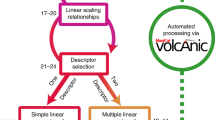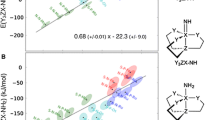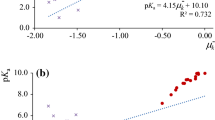Abstract
Descriptor-based analysis is a powerful tool for understanding the trends across various catalysts. In general, the rate of a reaction over a given catalyst is a function of many parameters—reaction energies, activation barriers, thermodynamic conditions, etc. The high dimensionality of this problem makes it very difficult and expensive to solve completely, and even a full solution would not give much insight into the rational design of new catalysts. The descriptor-based approach seeks to determine a few “descriptors” upon which the other parameters are dependent. By doing this it is possible to reduce the dimensionality of the problem—preferably to 1 or 2 descriptors—thus greatly reducing computational efforts and simultaneously increasing the understanding of trends in catalysis. The “CatMAP” Python module seeks to standardize and automate many of the mathematical routines necessary to move from “descriptor space” to reaction rates for heterogeneous (electro) catalysts. The module is designed to be both flexible and powerful, and is available for free online. A “reaction model” can be fully defined by a configuration file, thus no new programming is necessary to change the complexity or assumptions of a model. Furthermore, various steps in the process of moving from descriptors to reaction rates have been abstracted into separate Python classes, making it easy to change the methods used or add new functionality. This work discusses the structure of the code and presents the underlying algorithms and mathematical expressions both generally and via an example for the CO oxidation reaction.
Graphical Abstract





Similar content being viewed by others
References
Dumesic JA, Rudd DF, Aparicio LM et al (1994) The microkinetics of heterogeneous catalysis. AIChE J 40:1085–1087
Davis ME, Davis RJ (2003) Fundamentals of chemical reaction engineering. Chapter 7. McGraw-Hill, New York
Deutschmann O (2011) Modeling and simulation of heterogeneous catalytic reactions: from the molecular process to the technical system. Wiley, Weinheim
Stoltze P (2000) Microkinetic simulation of catalytic reactions. Prog Surf Sci 65:65–150. doi:10.1016/S0079-6816(00)00019-8
Reuter K, Scheffler M (2006) First-principles kinetic Monte Carlo simulations for heterogeneous catalysis: application to the CO oxidation at RuO2(110). Phys Rev B 73:045433. doi:10.1103/PhysRevB.73.045433
Hoffmann MJ, Matera S, Reuter K (2014) kmos: a lattice kinetic Monte Carlo framework. Comput Phys Commun 185:2138–2150. doi:10.1016/j.cpc.2014.04.003
Honkala K, Hellman A, Remediakis IN et al (2005) Ammonia synthesis from first-principles calculations. Science 307:555–558
Andersson MP, Bligaard T, Kustov A et al (2006) Toward computational screening in heterogeneous catalysis: pareto-optimal methanation catalysts. J Catal 239:501–506. doi:10.1016/j.jcat.2006.02.016
Cheng J, Hu P (2008) Utilization of the three-dimensional volcano surface to understand the chemistry of multiphase systems in heterogeneous catalysis. J Am Chem Soc 130:10868–10869. doi:10.1021/ja803555g
Nørskov JK, Bligaard T, Rossmeisl J, Christensen CH (2009) Towards the computational design of solid catalysts. Nat Chem 1:37–46. doi:10.1038/nchem.121
Nørskov JK, Abild-Pedersen F, Studt F, Bligaard T (2011) Density functional theory in surface chemistry and catalysis. Proc Natl Acad Sci USA 108:937–943. doi:10.1073/pnas.1006652108
Grabow LC, Mavrikakis M (2011) Mechanism of methanol synthesis on Cu through CO2 and CO hydrogenation. ACS Catal 1:365–384. doi:10.1021/cs200055d
Rankin RB, Greeley J (2012) Trends in selective hydrogen peroxide production on transition metal surfaces from first principles. ACS Catal 2:2664–2672. doi:10.1021/cs3003337
Wang H, Schneider WF (2012) Comparative chemistries of CO and NO oxidation over RuO2 (110): insights from first-principles thermodynamics and kinetics. Mol Simul 38:615–630. doi:10.1080/08927022.2012.671521
Vendelbo SB, Elkjær CF, Falsig H et al (2014) Visualization of oscillatory behaviour of Pt nanoparticles catalysing CO oxidation. Nat Mater 13:884–890. doi:10.1038/nmat4033
Abild-Pedersen F, Greeley J, Studt F et al (2007) Scaling properties of adsorption energies for hydrogen-containing molecules on transition-metal surfaces. Phys Rev Lett 99:016105. doi:10.1103/PhysRevLett.99.016105
Logadottir A, Rod TH, Norskov JK et al (2001) The Brønsted–Evans–Polanyi Relation and the volcano plot for ammonia synthesis over transition metal catalysts. J Catal 197:229–231. doi:10.1006/jcat.2000.3087
Michaelides A, Liu Z-P, Zhang CJ et al (2003) Identification of general linear relationships between activation energies and enthalpy changes for dissociation reactions at surfaces. J Am Chem Soc 125:3704–3705. doi:10.1021/ja027366r
van Santen RA, Neurock M, Shetty SG (2010) Reactivity theory of transition-metal surfaces: a Brønsted-Evans-Polanyi linear activation energy-free-energy analysis. Chem Rev 110:2005–2048. doi:10.1021/cr9001808
Wang S, Temel B, Shen J et al (2010) Universal Brønsted-Evans-Polanyi relations for C-C, C–O, C–N, N–O, N–N, and O–O dissociation reactions. Catal Lett 141:370–373. doi:10.1007/s10562-010-0477-y
Wang S, Petzold V, Tripkovic V et al (2011) Universal transition state scaling relations for (de)hydrogenation over transition metals. Phys Chem Chem Phys 13:20760–20765. doi:10.1039/c1cp20547a
Medford AJ, Vojvodic A, Hummelshøj JS, et al (2015) From the Sabatier principle to a predictive theory of transition-metal heterogeneous catalysis. J Catal (Accepted)
Jacobsen CJH, Dahl S, Clausen BS et al (2001) Catalyst design by interpolation in the periodic table: bimetallic ammonia synthesis catalysts. J Am Chem Soc 123:8404–8405. doi:10.1021/ja010963d
Studt F, Abild-Pedersen F, Wu Q et al (2012) CO hydrogenation to methanol on Cu–Ni catalysts: theory and experiment. J Catal 293:51–60. doi:10.1016/j.jcat.2012.06.004
Greeley J, Mavrikakis M (2004) Alloy catalysts designed from first principles. Nat Mater 3:810–815. doi:10.1038/nmat1223
Greeley J, Jaramillo TF, Bonde J et al (2006) Computational high-throughput screening of electrocatalytic materials for hydrogen evolution. Nat Mater 5:909–913. doi:10.1038/nmat1752
Hansgen DA, Vlachos DG, Chen JG (2010) Using first principles to predict bimetallic catalysts for the ammonia decomposition reaction. Nat Chem 2:484–489. doi:10.1038/nchem.626
Hummelshøj JS, Abild-Pedersen F, Studt F et al (2012) CatApp: a web application for surface chemistry and heterogeneous catalysis. Angew Chem Int Ed Engl 51:272–274. doi:10.1002/anie.201107947
Campbell CT (1994) Micro- and macro-kinetics : their relationship in heterogeneous catalysis. Top Catal 1:353–366
Stegelmann C, Andreasen A, Campbell CT (2009) Degree of rate control: how much the energies of intermediates and transition states control rates. J Am Chem Soc 131:8077–8082. doi:10.1021/ja9000097
Brown WA, Kose R, King DA (1998) Femtomole adsorption calorimetry on single-crystal surfaces. Chem Rev 98:797–832. doi:10.1021/cr9700890
Johnson RDI (2011) NIST Computational Chemistry Comparison and Benchmark Database. NIST Stand Ref, Database Number 101
Enkovaara J, Rostgaard C, Mortensen JJ et al (2010) Electronic structure calculations with GPAW: a real-space implementation of the projector augmented-wave method. J Phys 22:253202. doi:10.1088/0953-8984/22/25/253202
Hammer B, Hansen L, Nørskov J (1999) Improved adsorption energetics within density-functional theory using revised Perdew-Burke-Ernzerhof functionals. Phys Rev B 59:7413–7421. doi:10.1103/PhysRevB.59.7413
Nørskov JK, Rossmeisl J, Logadottir A et al (2004) Origin of the overpotential for oxygen reduction at a fuel-cell cathode. J Phys Chem B 108:17886–17892. doi:10.1021/jp047349j
Klüpfel S, Klüpfel P, Jónsson H (2012) The effect of the Perdew-Zunger self-interaction correction to density functionals on the energetics of small molecules. J Chem Phys 137:124102. doi:10.1063/1.4752229
Peterson AA, Abild-Pedersen F, Studt F et al (2010) How copper catalyzes the electroreduction of carbon dioxide into hydrocarbon fuels. Energy Environ Sci 3:1311. doi:10.1039/c0ee00071j
Jiang T, Mowbray DJ, Dobrin S et al (2009) Trends in CO oxidation rates for metal nanoparticles and close-packed, stepped, and kinked surfaces. J Phys Chem C 113:10548–10553. doi:10.1021/jp811185g
Grabow LC, Hvolbæk B, Nørskov JK (2010) Understanding Trends in catalytic activity: the effect of adsorbate-adsorbate interactions for CO oxidation over transition metals. Top Catal 53:298–310. doi:10.1007/s11244-010-9455-2
Mason S, Grinberg I, Rappe A (2004) First-principles extrapolation method for accurate CO adsorption energies on metal surfaces. Phys Rev B 69:161401. doi:10.1103/PhysRevB.69.161401
Abild-Pedersen F, Andersson MP (2007) CO adsorption energies on metals with correction for high coordination adsorption sites—a density functional study. Surf Sci 601:1747–1753. doi:10.1016/j.susc.2007.01.052
Shomate CH (1954) A method for evaluating and correlating thermodynamic data. J Phys Chem 58:368–372. doi:10.1021/j150514a018
Nørskov JK, Studt F, Abild-Pedersen F, Bligaard T (2014) Fundamental concepts in heterogeneous catalysis. Wiley, New York
McQuarrie D (2000) Statistical mechanics. University Science Books, Sausalito
Karplus M, Kushick JN (1981) Method for estimating the configurational entropy of macromolecules. Macromolecules 14:325–332. doi:10.1021/ma50003a019
Vojvodic A, Calle-Vallejo F, Guo W et al (2011) On the behavior of Brønsted-Evans-Polanyi relations for transition metal oxides. J Chem Phys 134:244509. doi:10.1063/1.3602323
Moore EH (1920) On the reciprocal of the general algebraic matrix. Bull Am Math Soc 26:385–397
Penrose R, Todd JA (1955) A generalized inverse for matrices. Math Proc Camb Philos Soc 51:406. doi:10.1017/S0305004100030401
Hammer B, Norskov JK (1995) Why gold is the noblest of all the metals. Nature 376:238–240. doi:10.1038/376238a0
Axelsson O (1996) Iterative solution methods. Cambridge University Press, Cambridge
Xu Y, Lausche AC, Wang S et al (2013) In silico search for novel methane steam reforming catalysts. New J Phys 15:125021. doi:10.1088/1367-2630/15/12/125021
Lausche AC, Medford AJ, Khan TS et al (2013) On the effect of coverage-dependent adsorbate–adsorbate interactions for CO methanation on transition metal surfaces. J Catal 307:275–282. doi:10.1016/j.jcat.2013.08.002
Medford AJ, Lausche AC, Abild-Pedersen F et al (2014) Activity and selectivity trends in synthesis gas conversion to higher alcohols. Top Catal 57:135–142. doi:10.1007/s11244-013-0169-0
Johansson F (2010) mpmath: a Python library for arbitrary-precision floating-point arithmetic (version 0.14)
Reuter K, Scheffler M (2003) First-principles atomistic thermodynamics for oxidation catalysis: surface phase diagrams and catalytically interesting regions. Phys Rev Lett 90:046103. doi:10.1103/PhysRevLett.90.046103
Li T-Y (1997) Numerical solution of multivariate polynomial systems. Acta Numer 6:399–436. doi:10.1017/S0962492900002749
Gusmão GS, Christopher P (2014) A general and robust approach for defining and solving microkinetic catalytic systems. AIChE J. doi:10.1002/aic.14627
Chandler JP, Hill DE, Spivey HO (1972) A program for efficient integration of rate equations and least-squares fitting of chemical reaction data. Comput Biomed Res 5:515–534. doi:10.1016/0010-4809(72)90058-4
Coltrin ME, Kee RJ, Rupley FM (1991) Surface chemkin: a general formalism and software for analyzing heterogeneous chemical kinetics at a gas-surface interface. Int J Chem Kinet 23:1111–1128. doi:10.1002/kin.550231205
Acknowledgments
We acknowledge David Fenning and Maureen Tang for their help in naming CatMAP. Support from the DOE Office of Basic Energy Science to the SUNCAT Center for Interface Science and Catalysis is gratefully acknowledged. AJM is grateful for support by the Department of Defense (DoD) through the National Defense Science & Engineering Graduate Fellowship (NDSEG) Program.
Author information
Authors and Affiliations
Corresponding author
Rights and permissions
About this article
Cite this article
Medford, A.J., Shi, C., Hoffmann, M.J. et al. CatMAP: A Software Package for Descriptor-Based Microkinetic Mapping of Catalytic Trends. Catal Lett 145, 794–807 (2015). https://doi.org/10.1007/s10562-015-1495-6
Received:
Accepted:
Published:
Issue Date:
DOI: https://doi.org/10.1007/s10562-015-1495-6




